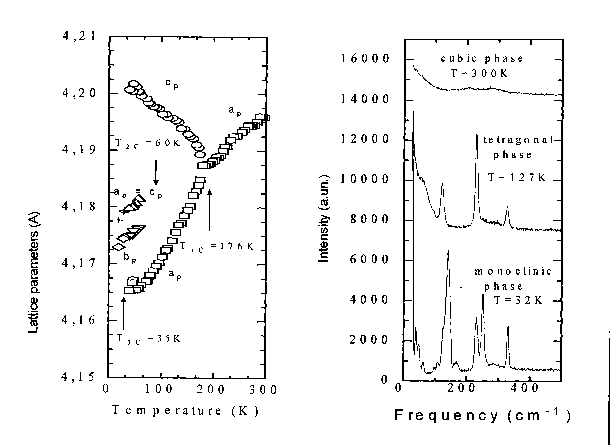
HOW SMALL ADMIXTURES (X<=0.15) OF ALKALII METALS (Li+1, Na+1 AND Rb+1) INFLUENCE ON THE STRUCTURAL AND DYNAMICAL PROPERTIES OF KMNF3 ?
Joanna Kapusta1, Philippe Daniel2 and Alicja Ratuszna1
1Institute of Physics, University of
Silesia Uniwersytecka 4, 40-007 Katowice (Poland)
2Laboratoire de Physique de l'Etat
Condens UPRES A CNRS no6087,
Universit du Maine Avenue O.Messiaen, 72085 Le Mans Cedex
9 (France) E-mail:jkapusta@usctoux1.cto.us.edu.pl
Keywords: Perovskite-type crystals, structural phase transitions, Raman scattering, X-ray diffraction
KMnF3 belongs to the family of perovskite-type crystals and it has been extensively studied [1-3] because of its simple structure (Pm3m at room temperature) and ability to undergo a variety of the structural phase transitions (SPT), which are related to the rotations of MnF6 octahedra.
Single crystals of (AxK1-x)MnF3 (where A=Li+1, Na+1 and Rb+1), which were grown by the Bridgman technique [4] were studied by Raman scattering and X-ray diffraction methods in the temperature range from 300 to 10K.
Aim of the paper was to study an influence of the substitution of K cations by alkali metals with radii bigger than K+ such as Rb+ and smaller - Na+1 and Li+1 on the character of the SPTs, their temperatures, sequences and mechanism of the structural distortions.
For "pure" KMnF3 the observed sequences of SPT may be written in Glazer's notation [5] as:
a0a0a0 => a0a0c- => a-b+a-
cubic T1C=186K => tetragonal T2C=91K=> monoclinic
This scheme changes when admixtures are introduced into crystals. Figure 1 shows the experimental data obtained from X-ray diffraction (fig.1a) and Raman scattering (fig.1b) methods for KMnF3 doped by 1% of Rb.

Figure 1. Experimental data for KMnF3 doped by 1% of Rb a) Plot of lattice parameters versus temperature and b) Evolution of Raman lines versus temperature
The main conclusions from X-ray data are:
1) The dopants introduced into KMnF3 changed the temperatures of SPT
2) The sequences of the structural distortions are changed compare to "pure" KMnF3 because of the competition of the different kinds of interactions responsible for the deformation
3) The order parameter , which describes the character of the high temperature phase transition indicates that SPT depends strongly on the kind of dopants, not on their numbers
These conclusions are confirmed by Raman experiments but some additional information about high temperature cubic symmetry were obtained.
The presence of the tetragonal "hard Raman modes" and the cubic broad bands with two phonon process shown in fig.1b are an evidence of disorderd structure in cubic phase. The alkalii ions are responsible for appearence of the clusters, where MnF6 octahedra are differently rotated around one of the major cubic axes in each cluster giving pseudo-glass structure [6,7].
1. D.Lockwood, B.Torri, J.Phys.
C: Solid State Physic 7 (1974) 2729-2744
2. A.Ratuszna, J.Phys.Condens.Matter 5 (1993)
841-850
3. A.Ratuszna, J.Kapusta, Phase Transitions 62
(1997) 181-198
4. D.Skrzypek, P.J.Jakubowski, A.Ratuszna, A.Chełkowski, J.Cryst.Growth
48 (1980) 475-477
5. A.Glazer, Acta Cryst. B28 (1972) 3384-3392
6. A.Ratuszna, Ph.Daniel, J.Kapusta, M.Rousseau, Phys.Rev.B
(1998) -accepted to print
7. J.Kapusta, Ph.Daniel, A.Ratuszna, Phys.Rev.B -sent to
the Editor